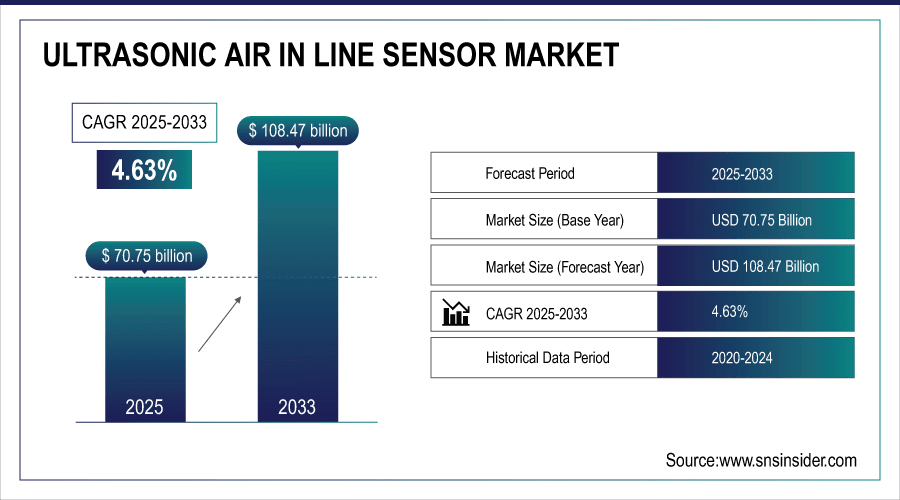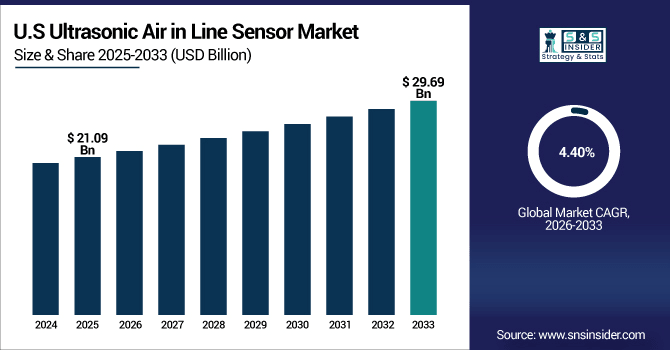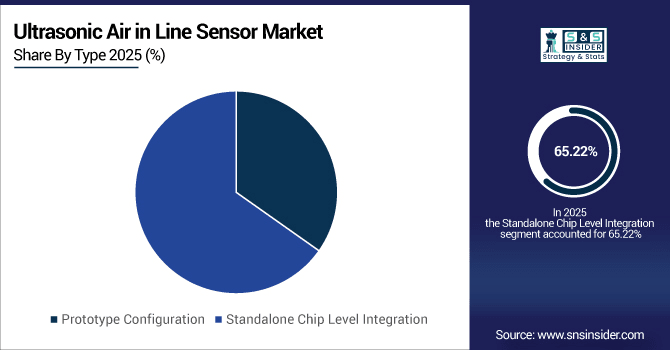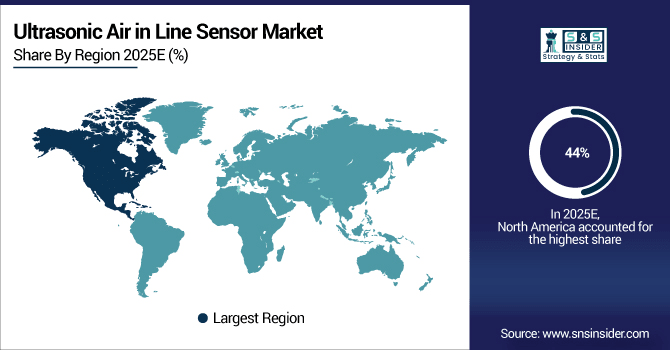Ultrasonic Air in Line Sensor Market Size Analysis:
The Ultrasonic Air in Line Sensor Market size was valued at USD 70.75 Billion in 2025E and is projected to reach USD 108.47 Billion by 2033, growing at a CAGR of 4.63% during 2026-2033.
The Ultrasonic Air in Line Sensor Market is expanding due to the increasing demand for precise fluid measurement by varied industries, such as medical devices, industrial automation, and automotive. Next generation devices are being propelled by sensor’s miniaturization and its assimilation with digital interfaces. Growing demand in predictive maintenance, process control & safety is also an intervening factor towards the market.
Rising adoption in medical devices (accounting for ~40% of demand) and advancements in MEMS-based sensors (driving ~30% performance improvement) are key growth enablers.

To Get More Information On Ultrasonic Air in Line Sensor Market - Request Free Sample Report
Ultrasonic Air in Line Sensor Market Trends
-
Growing demand of precise air detection in equipments such as infusion pumps and dialysis system is facilitating the business demand.
-
Ultrasonic sensors are increasingly used in industrial applications due to the increased automation and inline control of manufacturing processes.
-
IOT connected ultrasonic sensors have improved digital signal processing and give you real time monitoring, analysis as well as enhanced performance in various applications.
-
EV systems, fluid monitoring, robotics, and predictive maintenance are among new growth opportunities outside healthcare applications.
-
Regulatory focus on patient safety and need for accurate sensing are pushing innovation and adoption in a number of fields.
The U.S. Ultrasonic Air in Line Sensor Market size was valued at USD 21.09 Billion in 2025E and is projected to reach USD 29.69 Billion by 2033, growing at a CAGR of 4.40%during 2026-2033. Ultrasonic Air in Line Sensor Market growth is driven by high demand for sophisticated medical equipment, especially infusion pumps and dialysis machines, where preciseness of air detection is instrumental to the safety of the patient. Increasing the investment in industrial automation and in Industry 4.0 initiatives drives the requirement for inline monitoring solutions still higher. The automotive industry is contributing, too, using sensors more in EV battery management and for fuel systems.

Increased focus on predictive maintenance and process optimization is driving adoption of ultrasonic sensing by manufacturers. Health care and aerospace also benefit, as permissive legislation and quality control standards gain greater adoption in the marketplace.
Ultrasonic Air in Line Sensor Market Growth Drivers:
-
Growing Medical Applications, Rising Automation, and Advancements in Sensor Miniaturization Accelerate Global Adoption.
The rising demand for accurate air detection in the medical equipment such as the infusion pumps and dialysis systems has been fuelling the market of Ultrasonic Air-in-Line Sensor. Fast industrial automation and Industry 4.0 penetration are also adding to application in inline monitoring systems. Reduced and integrated digital signal processing improve performance and applicability in many fields. Regulatory focus on patient safety and process robustness keeps the ball rolling. Together, these factors contribute to stable growth in the healthcare, automotive, and industrial areas.
Industrial automation and Industry 4.0 initiatives are projected to account for over 35% of market growth, with North America and Asia-Pacific leading adoption due to stringent patient safety regulations and smart manufacturing expansion.
Ultrasonic Air in Line Sensor Market Restraints:
-
High Costs, Integration Challenges, and Competition from Alternative Sensing Technologies Slow Adoption Pace
Small to mid-tier manufacturers need to invest heavily in the development and production, preventing to focus on rapid product growth in most cases. Problems with integrating into compact or older equipment add to the burden of adopting. Challenges from passive sensing, optical, MEMS, thermal sensing, etc., promote the competition between ultrasonic-only solutions. It also depends on how accurate it is in different conditioning environments (like temperatures and humidities). These constraints hinder higher scaling velocity, particularly in terms of cost-constrained markets.
Ultrasonic Air in Line Sensor Market Opportunities:
-
IoT Integration, Predictive Maintenance, and Expanding Applications in Automotive and Industrial Automation Unlock Growth
There are huge market opportunities through Internet of Things (IoT) based ultrasonic sensors with live monitoring and analysis. More use cases in other segments, such as predictive maintenance and smart factory, are increasing beyond healthcare. The automotive is expected to increase use of in EV systems and fluid monitoring drives demand. Precision over sensing is another driver of future growth in industrial automation and robotics. Diversification across industries introduces new avenues for innovation and revenue generation.
In 2024–2025, the IoT-enabled ultrasonic air-in-line sensor segment is projected to grow by over 12% annually, with smart factory deployments accounting for nearly 30% of new installations.
Ultrasonic Air in Line Sensor Market Segment Analysis
-
By Technology, ultrasonic level sensors are projected to lead the market with an estimated 42.67% share in 2025, while ultrasonic flow sensors are expected to be the fastest growing segment with a CAGR of 5.31%.
-
By Application, dialysis and transfusions are anticipated to dominate with around 39.13% share in 2025, whereas heart-lung machines are forecasted to register the highest growth with a CAGR of 5.61%.
-
By Type, standalone chip level integration is expected to lead with approximately 65.22% share in 2025, while prototype configuration is likely to grow fastest at a CAGR of 4.79%.
-
By End-User, hospitals and home care settings are projected to hold the largest share at 62.89% in 2025, whereas academic and research institutes are set to be the fastest-growing category with a CAGR of 5.20%.
By Type, Standalone Chip Level Integration Lead While Prototype Configuration Registers Fastest Growth
Stand-alone chip-level integration for medical devices 9 Ease of implementation All-in-one solutions that enable accurate dimensioning and trouble free integration with other systems. It’s prototype formats that are growing most rapidly, though, as manufacturers develop and test new formats and features to better address changing clinical needs. Time-to-market of novel solutions is reduced via rapid prototyping and iteratively testing. Miniaturization and performance optimization are the two factors which drive this progression.

By Technology, Ultrasonic Level Sensors Leads Market While Ultrasonic Flow Sensors Registers Fastest Growth
Ultrasonic level sensors presently dominate the market due to their use in a wide range of liquid measurement and monitoring solutions. These sensors offer precise non-contact readings that are ideal for both medical and industrial applications. Meanwhile, ultrasonic flow sensors are noted as the fast-growing one, driven by a soaring demand for accurate flow surveillance in intricate applications. Technology advances in the sensors and connection to digital ecosystems further contribute to accelerating their penetration. Sensitivity, accuracy, and stability are the three crucial factors that manufacturers are focusing more in R&D.
By Application, Dialysis and Transfusions Dominate While Heart-Lung Machines Shows Rapid Growth
On the basis of end user, dialysis and transfusion devices are the most used because patient care is impossible without it. These apps are also used widely by hospitals and clinics to push life-saving treatment in an efficient manner. Dez06) As services for cardiac surgery and complex medical interventions are on the rise, heart-lung-machines are increasing in numbers. Advances in the technology of these instruments are enhancing the efficiency and safety for the patient. Growing prevalence of chronic diseases and surgical procedures also fuels the market growth.
By End-User, Hospitals and Home Care Settings Lead While Academic and Research Institutes Grow Fastest
Hospitals and home care environments drive the market as the need for reliable monitoring and therapeutic equipment remains essential. These settings value easy-of-use, reliability and patient safety in their equipment selections. Academic and research institutions will also be the fastest growing market for this equipment, with growing demand for advanced sensors due to more investment in medical research and experimental uses. It is common practice for institutions to introduce novel technology prior to broad clinical utilization. Collaborations with manufacturers and research institutes also help speed up commercialization.
North America Ultrasonic Air in Line Sensor Market Insights
In 2025E North America dominated the Ultrasonic Air in Line Sensor Market and accounted for 44% of revenue share, this leadership is due to the large share in the global ultrasonic air in line sensor market, owing to the developed healthcare infrastructure and increasing usage of advanced medical equipment. The region has a strong presence of large manufacturers as well as research institutes, which support innovation and development of products. Moreover, the demand for trustable and accurate sensing solutions are driven due to the stringent regulatory requirements and patient's safety focus.

Get Customized Report as Per Your Business Requirement - Enquiry Now
U.S. Ultrasonic Air in Line Sensor Market Insights
U.S. is the dominant consumer of ultrasonic air in line sensor due to the large number of healthcare sector and there is high demand for modern medical devices in this region. The rising incidence of chronic diseases from the country´s ageing population and poor lifestyle habits also means more specialized medical equipment is required. Besides this, continuous development and research activities being carried out in medical technologies pave the way for novel sensing solutions.
Asia Pacific Ultrasonic Air in Line Sensor Market Insights
Asia Pacific is expected to witness the fastest growth in the Ultrasonic Air in Line Sensor Market over 2026-2033, with a projected CAGR of 10.38 due to growing healthcare infrastructure coupled with increasing demand for advanced medical devices. The health sector is growing in countries such as India and China, which again is leading in the purchase of specialized equipment. Introduction of newer technologies and increasing emphasis on patient safety continue to drive the growth in market.
China Ultrasonic Air in Line Sensor Market Insights
The China market for the ultrasonic air in line sensor exhibits a massive opportunity. Strong levels of care with rising incidence of chronic conditions boosts demand for sophisticated medical devices in the country. State-led programs that are focused on upgrading healthcare facilities and services also boost market penetration.
Europe Ultrasonic Air in Line Sensor Market Insights
In 2025E, Europe emerged as a promising region in the Ultrasonic Air in Line Sensor Market, due to high standard, making it possible to have trust and dependability on the ultrasonic sensing technologies. The continuously enhancement and evolution of functions are realized by cooperation between healthcare providers and manufacturers. The ultrasonic air in line sensor market in the Europe is continuously progressing on the back of the growing healthcare excellence.
Germany Ultrasonic Air in Line Sensor Market Insights
Germany is also known for its focus on research and development in medical devices, which encourages the adoption of the latest sensing solutions. In addition, the country’s compliance with strict regulatory requirements guarantees the quality and safety of medical devices. These circumstances make Germany the most prominent country in the European market
Latin America (LATAM) and Middle East & Africa (MEA) Ultrasonic Air in Line Sensor Market Insights
The Ultrasonic Air in Line Sensor Market is experiencing moderate growth in the Latin America (LATAM) and Middle East & Africa (MEA) regions, due to the developing healthcare infrastructure and increasing concern for patient safety. The demand for improved healthcare facilities and penetration of advanced medical devices is increasing in the region which is driving investments in advanced medical technologies in these regions. Market expansion is also being driven by partnerships with global manufacturers and institutions.
Ultrasonic Air in Line Sensor Market Competitive Landscape:
SONOTEC GmbH is the world leading company for ultrasonic measurement technology with core competences in the field of non-invasive liquid monitoring and air bubble detection. The company provides the SONOFLOW IL product. 52 and SONOCHECK ABD series, are commonly used in medicine to protect patients, by detecting air bubbles in the fluid lines.
-
In June 2025E, Mersen has extended its 1500VDC HelioProtection 20x65mm PV fuses to include 63A and 65A models, now covering 20A–65A In August 2025, SONOTEC showcased its latest sensor technologies at the ECerS Conference in Dresden, Germany, highlighting advancements in ultrasonic measurement solutions.
Biosonix is a medical sensor ultrasonic technology company. Their product offerings are specially conceived to deliver precise and intuitive measurements, augmenting both staff and patient safety, and the overall effectiveness of their healthcare facility. A characteristic aspect of the sensors developed by Biosonix are that they are non-invasive, decreasing the risk of complications and increasing patient comfort.
-
In July 2025, Biosonix announced the launch of a new ultrasonic sensor model designed for real-time monitoring of air bubbles in intravenous lines, enhancing patient safety during medical treatments.
TE Connectivity is a global industrial technology leader creating a safer, sustainable, productive, and connected future. Their ultrasonic sensors are well-suited for air bubble detection, liquid level monitoring and liquid flow control in marketing applications such as clinical, automotive and industrial. TE Connectivity's sensors are wellknown for quality, reliability, and proven performance in the harshest environments.
-
In June 2025, TE Connectivity introduced a new line of ultrasonic sensors featuring enhanced EMI/RFI immunity and continuous self-testing capabilities, aimed at improving performance in medical pump applications.
CeramTec GmbH is a manufacturer of high-performance ceramics and advanced ceramic components and materials for use in Industry, Medical Technology, Automotive, Electronic devices and General Equipment technology. Although not yet known for these traditional ultrasonic sensor applications, CeramTec bring ceramic materials to the table able to provide significant input to future sensor technologies.
-
In May 2025, CeramTec announced a collaboration with a leading sensor manufacturer to develop advanced ceramic components for next-generation ultrasonic sensors, aiming to improve sensor performance in medical applications.
Ultrasonic Air in Line Sensor Companies are:
-
Biosonix
-
TE Connectivity
-
CeramTec GmbH
-
Sensaras LLC
-
Introtek International
-
Moog Inc.
-
Strain Measurement Devices
-
STMicroelectronics
-
Murata Manufacturing Co. Ltd.
-
Honeywell International Inc.
-
Analog Devices Inc.
-
Microchip Technology Inc.
-
TDK Corporation
-
Panasonic Holdings Corporation
-
Safran S.A.
-
Emerson Electric Co.
-
Siemens AG
-
General Electric
| Report Attributes | Details |
|---|---|
| Market Size in 2025 | USD 75.70 Billion |
| Market Size by 2033 | USD 108.47 Billion |
| CAGR | CAGR of 4.63% From 2026 to 2033 |
| Base Year | 2025E |
| Forecast Period | 2026-2033 |
| Historical Data | 2022-2024 |
| Report Scope & Coverage | Market Size, Segments Analysis, Competitive Landscape, Regional Analysis, DROC & SWOT Analysis, Forecast Outlook |
| Key Segments | • By Technology (Ultrasonic Level Sensors, Ultrasonic Flow Sensors, Ultrasonic Distance Sensors and Ultrasonic Thickness Gauges) • By Application (Dialysis and Transfusions, Heart-Lung Machines, Blood separators, Pumps for Medical Technology and Diagnostic Systems, and Other Devices • By Type (Prototype Configuration and Standalone Chip Level Integration) • By End-User (Hospitals and Home Care Settings and Academic and Research Institutes) |
| Regional Analysis/Coverage | North America (US, Canada), Europe (Germany, UK, France, Italy, Spain, Russia, Poland, Rest of Europe), Asia Pacific (China, India, Japan, South Korea, Australia, ASEAN Countries, Rest of Asia Pacific), Middle East & Africa (UAE, Saudi Arabia, Qatar, South Africa, Rest of Middle East & Africa), Latin America (Brazil, Argentina, Mexico, Colombia, Rest of Latin America). |
| Company Profiles | SONOTEC GmbH, Biosonix, TE Connectivity, CeramTec GmbH, Piezo Technologies, Sensaras LLC, Introtek International, Moog Inc., Strain Measurement Devices, STMicroelectronics, Murata Manufacturing Co. Ltd., Honeywell International Inc., Analog Devices Inc., Microchip Technology Inc., TDK Corporation, Panasonic Holdings Corporation, Safran S.A., Emerson Electric Co., Siemens AG, General Electric |

